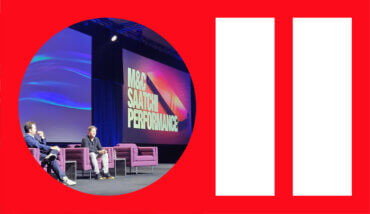Industry experts tell MyCustomer.com about the biggest developments in marketing this year and outline what we have learned.
The growth of mobile and social channels, as well as the evolution of consumer technology, significantly altered the marketing landscape in 2012. As did events such as the change to consumer information privacy law, the Olympic Games and the introduction of brand domain names.
Industry experts take a look back over the past 12 months to explain new trends, major developments and how this affects the industry going forward
Growing social sophistication
If the past two years was about businesses stepping cautiously around social media, 2012 was the year that saw marketers become more confident with their customer-facing social activities.
Sylvia Jensen, director of marketing for EMEA at Eloqua believes that 2012 marked the year that businesses seriously began to consider social as an integral part of their marketing strategy.
“B2B marketers in particular are increasingly embracing social media but are still unsure how to tie social media efforts to revenue performance. In 2012, marketers stopped talking about social as if it’s a fad and began exploring how best to integrate social media throughout their multi-channel campaigns.
“Social monitoring has become standard and now marketers are asking what more they can do and how to appropriately incorporate social at various touch points to improve the customer experience.”
Nevertheless, Penny Hutton from Eclipse Marketing argues that whilst brands are beginning to grow in social confidence, they’re still very much in the early stages.
“Brands are really beginning to grasp the horns of social media rather than sticking their heads in the sand. But, plenty are still uncertain of where the management of social media interaction should lie, resulting in untimely and disjointed consumer interactions. There’s still a long way to go. The struggle is still to provide enough content and stay relevant!”
Jon Buss, MD at Experian Digital, agrees that this isn’t the only obstacle marketers must overcome if they are to excel at social.
“Consumers became increasingly engaged via social media in 2012; Facebook passed the 1 billion user mark, there were more than 500 million active Twitter users and Pinterest saw an unprecedented growth in traffic when it emerged from its initial beta stage,” he says.
“The continued challenge for marketers is to decide which of these channels represent the right fit for their business, how they should get involved and how much they should invest in ensuring that social experiences are beneficial to the business and the brand.
“Many marketers remain concerned that they are not using social channels correctly or getting the most out of them. While models to demonstrate true return on investment are still in creation, the real opportunity for marketers lies within the new realms of data that these social channels create and how they can use the data to better understand their customers and improve their marketing strategies accordingly.”
Indeed, just as ROI and accountability has become a bigger issue in the marketing discipline in recent years, so the same demands are being required of social media initiatives. This is something that Steve Richards, MD at Yomego, believes has been a defining trend of the past 12 months: “The biggest trend for me in 2012 was the focus on trying to measure social in a way that enables it to stand alongside to other marketing channels.
“Brands and agencies, along with industry bodies are now sitting up and taking this seriously – and with good reason. Social media needs these metrics to make its case more strongly and get the budgets it deserves.”
Social, local, mobile
Device sales of both tablets and smartphones has skyrocketed this year. And this has been reflected in usabilty and engagement statistics, with figures from Nielsen showing the amount of time consumers spend on mobile apps and the mobile web has increased 63% over the past 12 months. Unsurprisingly, in 2012 marketers were over mobile like white on rice.
“People have predicted at the start of every year, for at least the last five years that ‘This is the year of the mobile’,” says Martin Smith, head of marketing, “I’d say that 2012 has really been the year that mobile marketing truly came of age enabled through both technological advancement and the cultural adoption of social/mobile communication. The growth in the use of smartphones and tablets is relentless.”
Furthermore, this year the combination of related trends culminated in the emergence of the SoLoMo marketing approach. “Clearly, such high adoption rates in smartphones and tablets, combined with shoppers’ increasing use of these devices in doing their shopping, provide marketers with a great opportunity to converse with consumers via their platform of choice – with highly relevant, location-based communications that are highly engaging.”
Seamless cross-channel marketing
But according to Smith, “SoLoMo only works if an organisation is delivering a consistent customer experience at every possible interaction with a brand.”
The explosion of mobile and social channels this year has seen an increased customer-centric approach, with marketers now expected to deliver a unified and seamless experience to their customers across every channel.
“The lines between online and offline communications continued to blur in 2012 and cross-channel marketing became the norm for many brands; marketing evolved from a one-way flow of information to a two-way conversation (from the brand to the consumer and back again) thanks largely to digital channels,” says Buss.
Karine Del Moro, marketing director at Confirmit, says: “Customer experiences are becoming a real battleground in the fight to gain and retain customers, and brands are tied up in the experiences they provide.
“It’s becoming key for marketers to understand the customer experiences they offer so they can improve them, and use them to generate positive word of mouth. We’re seeing more marketers embracing Voice of the Customer programmes to give them this insight, and to help them to drive change into their marketing programmes.”
Zuora’sinternational marketing director, Geraldine Rizzo, adds: “We now live in a world where marketing success is not about how many products you ship. It’s about how strong your customer relationships are, and how good a job you are doing monetising those relationships.
“Those organisations that adopt a set of principles that put the customer at the heart of their approach will lead the way. Once they embrace a flexible, customer-centric business model, they will see those companies thrive in new and lasting ways.”
Major events
And this year has provided multiple opportunities for marketers to engage with consumers. James Hilton, M&C Saatchi Performance global CEO, explained mobile’s role in the Games: “Whether it’s watching live streaming of events, catching up on medal-winning highlights, or reading the latest news from the Olympic Park, UK consumers have used their mobiles to stay on top of all the action at London 2012.
“Recorded since the start of the London Olympics, M&C Saatchi Performance’s media-buying data also shows the important added accuracy and value that location provides to advertisers using the mobile platform. More than 50%, a 100% increase, of mobile display ads served so far during the Games have used location to target consumers in London specifically. Mobile location-based campaigns include money-off deals, relevant download opportunities, and other promotional offers from brands and companies with an outlet or presence in the city.”
This year also saw revisions to the EU cookie law, which saw power returned to the consumer. Following the ruling, brand websites must now give visitors clear and comprehensive information about the purposes for which the cookie is stored and accessed.
Andrew Bud from mBlox says of marketers’ need to secure consumer consent to use their data: “Mobile engagement marketing depends on this data – location, social graph, recent activity – to have the right conversations with the right consumers at the right time – for the consumer’s benefit. Now it’s been regulated. But consent is not just a tedious act of compliance – it’s about building consumer trust.”
2012 was also the year that introduced dot brand domain names. Roland LaPlante, CMO at Afilias, explains: “There was much excitement during the dot Brand application window in the first half of the year since brands and organisations at last had the chance to apply for custom domains like .Hermes or .Amazon rather than relying on old stand-bys like .com or .net. This important development in online identity will be reflected in marketing strategies through 2013 and beyond. That’s because these new dot Brand domains allow companies to offer greater consumer confidence and security as well as better integration between online and social channels.”
View full article here.
M&C Saatchi Performance is an award-winning performance media agency focused on driving measurable results for organisations in all industries. Feel free to get in touch with us about your new project.

